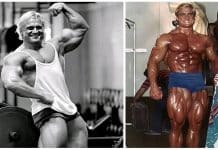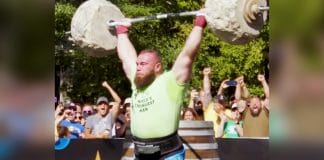Do You Need to Train to Muscle Failure for Hypertrophy
Training to muscle failure for hyperthrophy has a fairly cemented place in lifting culture. Vladimir Zatsiorsky in his book The Science and Practice of Strength Training wrote “a muscle fiber that is recruited but not fatigued is not being trained”[1]. However, bodybuilders and those seeking impressive hypertrophy gains have been training to muscle failure way before he published his book, so was he just confirming what others already knew to be true?
We’ve all heard pro bodybuilders talk about training with 100% effort every day and focusing on those last few reps. Hell, I’ll bet many of us would take a day of banging iron and yelling “lightweight” and “all you!” to our training partners over a half-assed workout, but as time goes on and we see more research being published on hypertrophy, I can’t help but wonder: is there a better way than training to muscle failure for hyperthophy?
Go Big or Go Home
To be fair, the traditional sense of bodybuilding is inspiring. Among weightlifting communities, an individual with an exceptionally well-rounded physique will always get the silent nods of approval from those that know what it takes to build muscle for a living. The first thing we need to get out of the way right off the bat is the distinction between being on or off gear. I have nothing against those who want to take advantage of the wonders of pharmacology (as long as it’s done correctly and safely), but we need to understand the difference between the physiological capabilities of natural and enhanced individuals. Since this article is about hypertrophy, a huge confounding factor with being enhanced is the recoverability it provides. That alone would change the outcome of the research, so for the sake of simplicity, I will say right now that all of the research reviewed on this topic is on natural participants.
How Much Should I Be Training?
You would be surprised at how little volume muscles need to grow. We see it all the time in novice lifters – those individuals that walk into the gym and in their first year or two see pretty amazing results if they put the work in. Only when they have that dumbfounded look on their faces when the same methods no longer work like they did those first couple of years do the rest of us smile and say “welcome to the show”.
While there are several studies on training volume associated with hypertrophy, there are not, unfortunately, many studies done on advanced trainees. However, we can still paint a pretty solid picture of what our aim should be. Wernbor et al. conducted a thorough meta-analysis of over 60 studies and concluded that while there is not enough evidence to make a recommendation for high-level lifters, both novice and intermediate will benefit more from higher frequency training per muscle group with novice trainees benefiting from training muscle group up to four times per week, and intermediate trainees training each muscle group two to three times per week[2]. The relationship seems to depend on a trainee’s ability to perform higher-effort sets and is also dependent on the volume that each muscle is exposed to. According to Wernbom and colleagues, the average frequency for muscle groups per week falls between two and three sessions per week. However, the data isn’t perfect on this and it should not be taken as doing two to three full training sessions per week per muscle group, but rather including an exercise or two for that muscle group several times per week. Now, onto the fun part.
More Pain, Less Gain
If you’re looking to get the most out of your workouts then you need to be ready to not only move some weight but be able to do so often. Before we dig into the data, think about the last time you either started a new program, or had an extremely high volume training session to failure – how did you feel the following days? I’d bet you were pretty banged up, and even though for some of us a high level of muscle soreness is looked at like a painful badge of honor, how likely do you think you would be to run through that same workout the next day?
Probably not very likely, and if you did, there’s a very high chance that your performance would not be close to that if you were fresh.
It was first believed that to get the highest amount of hypertrophy, you needed to achieve the highest amount of muscle damage. “No pain, no gain”, right? However, when researchers took a closer look at what was happening during the hours post-training from resistance training with a high degree of muscle damage, they found that the post-exercise increases in CSA (cross-sectional area) were largely due to swelling and MyoPS (myofibrillar protein synthesis) elevations were directed more towards muscle repair and remodeling but not associated with muscle hypertrophy[3]. In fact, It looks like increases in muscle hypertrophy tend to be inversely related to high levels of muscle damage[4, 5].
To be fair, this effect isn’t very long-lasting. Since we’re adaptation machines and due to the repeated bout effect, our bodies start to attenuate muscle damage, and the ratio of muscle hypertrophy increases. So if we eventually get used to the amount of muscle damage a given training session creates, how does training to muscle failure fit in?
 Muscle Failure versus Gains
Muscle Failure versus Gains
Given what we just read in the last paragraph, you might already be seeing the counter intuitive nature of always training to failure as the whole point of that style of training is to promote the highest amount of muscle damage possible. That’s not to say that you should never train to failure, just that the mechanisms might not always be conducive to growth.
For example, if you tend to train primarily with heavy loads there doesn’t seem to be any additional benefit to taking those sets to failure versus non-failure when the volume is equated[6]. However, when using low loads (around 30% 1RM) then a higher amount of effort is required to induce a hypertrophy response and that’s where training to failure has been shown to have a benefit.
In another study by Lacerda et al., participants were separated into two groups; muscle failure and non-muscle failure. The purpose of this study was to determine if repetitions to failure were less important than the total volume for hypertrophy and strength (which is the name of the study, evidently). The results were similar to several other papers showing that training to failure or 2-3 reps shy produced similar strength and hypertrophy results [7,8].
Final Word
Let’s review what we know so far: To see significant progress in muscle hypertrophy, we should look to train the target muscles 2 – 3 times per week. However, we also now understand that a large increase in volume can create too much muscle damage which can impede our ability to recover and grow. This would mean that deciding first on a total number of sets/week for a given muscle group should be a priority, then splitting that volume over a training week ensures that we can hit our working volume without creating too many “junk reps” that just cause us to fatigue.
Finally, the load that you select will determine the training style that you might use. If you’re training with a higher load (~80%), you can effectively train 2-3 reps away from failure and see the same results. As you start to decrease the load you will still see growth as the reps increase, but here is where you can start adding in sets to failure. The goal is to use movements that have the lowest effect on central fatigue and just create failure in the local muscle (i.e single-joint isolation movements work great here).
The majority of your training should be focused on attaining the highest quality of work in the gym with the least amount of downtime. Adding in too many sets to failure results in an increase of muscle damage, central fatigue, and can impede your ability to see consistent progress. That being said, a great way to add these types of sets in is a progression from week to week, for example, starting your first week 3 reps away from failure and working your way closer to muscle failure as the weeks progress either through an increase in load or reps.
References:
[1] Zatsiorsky, Vladimir M. 1995. Science and practice of strength training. Champaign, IL: Human Kinetics.
[2] Wernbom, Mathias, Jesper Augustsson, and Roland Thomeé. “The influence of frequency, intensity, volume and mode of strength training on whole muscle cross-sectional area in humans.” Sports medicine 37, no. 3 (2007): 225-264.
[3] Damas, Felipe, Stuart M. Phillips, Cleiton A. Libardi, Felipe C. Vechin, Manoel E. Lixandrão, Paulo R. Jannig, Luiz AR Costa et al. “Resistance training‐induced changes in integrated myofibrillar protein synthesis are related to hypertrophy only after attenuation of muscle damage.” The Journal of physiology 594, no. 18 (2016): 5209-5222.
[4] Mitchell, Cameron J., Tyler A. Churchward-Venne, Gianni Parise, Leeann Bellamy, Steven K. Baker, Kenneth Smith, Philip J. Atherton, and Stuart M. Phillips. “Acute post-exercise myofibrillar protein synthesis is not correlated with resistance training-induced muscle hypertrophy in young men.” PloS one 9, no. 2 (2014): e89431
[5] Wilkinson, Sarah B., Stuart M. Phillips, Philip J. Atherton, Rekha Patel, Kevin E. Yarasheski, Mark A. Tarnopolsky, and Michael J. Rennie. “Differential effects of resistance and endurance exercise in the fed state on signalling molecule phosphorylation and protein synthesis in human muscle.” The journal of physiology 586, no. 15 (2008): 3701-3717..
[6] Lasevicius, Thiago, Brad J. Schoenfeld, Carla Silva-Batista, T. de S. Barros, André Yui Aihara, Helderson Brendon, Ariel Roberth Longo, Valmor Tricoli, B. A. Peres, and Emerson Luiz Teixeira. “Muscle Failure Promotes Greater Muscle Hypertrophy in Low-Load but Not in High-Load Resistance Training.” Journal of Strength and Conditioning Research (2019).
[7] Lacerda, Lucas T., Rodrigo O. Marra-Lopes, Rodrigo CR Diniz, Fernando V. Lima, Sara A. Rodrigues, Hugo C. Martins-Costa, Michael G. Bemben, and Mauro H. Chagas. “Is Performing Repetitions to Failure Less Important Than Volume for Muscle Hypertrophy and Strength?.” The Journal of Strength & Conditioning Research 34, no. 5 (2020): 1237-1248.
[8] Nóbrega, Sanmy R., Carlos Ugrinowitsch, Lucas Pintanel, Cintia Barcelos, and Cleiton A. Libardi. “Effect of resistance training to muscle failure vs. volitional interruption at high-and low-intensities on muscle mass and strength.” The Journal of Strength & Conditioning Research 32, no. 1 (2018): 162-169.




 Muscle Failure versus Gains
Muscle Failure versus Gains












